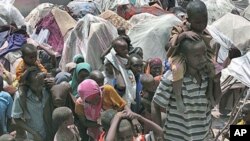Omar Osman, a spokesman for Somalia’s Transitional Federal Government (TFG), described his visit Wednesday with Prime Minister Abdiweli Mohamed Ali to three refugee camps in the capital Mogadishu.
“The conditions Mohamed Ali saw were appalling,” said Osman, “and he could not believe that some of the U.N. agencies had not reached those camps. At one of the camps we went to, we were informed that a child had died, just minutes before we visited.”
Relief workers say the Horn of Africa is experiencing the worst drought in six decades. The U.N. and the U.S. Agency for International Development says more than 11 million people are in need of food aid. Last week, the UN declared that famine has struck two regions in southern Somalia, which is under the control of the Islamic militant group, al-Shabab.
|
At the Dagahaley refugee camp in Dadaab, Kenya, families fleeing the famine in Somalia are given aid, but also face new challenges. VOA's Michael Onyiego visited the camp and took these pictures. |
Osman said the TFG will continue its efforts to combat the effects of the drought despite inadequate resources.
“As you are aware, the government has tried to do its best with its meager resources... We have seen a real famine. We have seen children close to dying even though the international community has politically pledged support to the Somali people to stop this hunger,” said Osman.
|
Definition of Famine: The word famine is a term that is not used lightly by humanitarian organizations. The United Nations describes a crisis as a famine only when the following conditions are met:
Current Famine:
|
He said agencies have been slow to provide famine relief.
“We urge the international community to speed up the process,” said Osman. “The situation cannot wait the normal procedure to take place. The situation is very urgent and dangerous.”
He said the prime minister has set up a committee to coordinate and assist international aid groups with their relief efforts. Osman praised ordinary Somalis for helping their fellow countrymen affected by the famine.
“We have seen a lot of effort from the Somali people. Civil society groups and local NGOs [non-governmental organizations] together with the government and the local administration… have done a lot, and they have re-settled some of these new arrivals to a new camp,” said Osman.
He adds the TFG will continue its coordination with international aid groups to send “much-needed” help to refugees living in areas outside the government’s control, despite threats by hard-line insurgent group, al-Shabab.
The United Nations says "massive" action is needed to save millions of people living in the Horn of Africa from starvation.
Meanwhile, a donors' conference was reportedly scheduled for Wednesday in Kenya's capital, Nairobi. The U.N. is seeking pledges of $1.6 billion to help the millions of malnourished people - many of them children.












